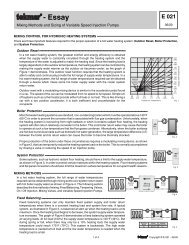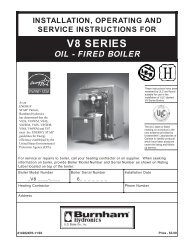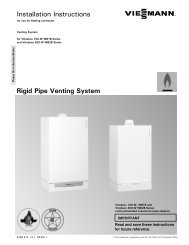Steam Locomotive Firebox Explosion on the Gettysburg Railroad ...
Steam Locomotive Firebox Explosion on the Gettysburg Railroad ...
Steam Locomotive Firebox Explosion on the Gettysburg Railroad ...
Create successful ePaper yourself
Turn your PDF publications into a flip-book with our unique Google optimized e-Paper software.
he said, “Open <strong>the</strong> bottom valves <strong>on</strong> <strong>the</strong><br />
sight glass, and it blows steam through <strong>the</strong><br />
glass to clean it.” He also said this was not<br />
to check <strong>the</strong> validity of <strong>the</strong> glass but “just<br />
<strong>the</strong> drain.” No crewmember was officially<br />
resp<strong>on</strong>sible for knowing <strong>the</strong> approved<br />
method of blowing down <strong>the</strong> water glass.<br />
The owner of <strong>Gettysburg</strong> <strong>Railroad</strong> (<strong>the</strong> engineer’s<br />
fa<strong>the</strong>r) and a <strong>Gettysburg</strong> Passenger<br />
Services employee who was qualified as<br />
both a steam-locomotive fireman and an engineer<br />
were each asked to explain and<br />
dem<strong>on</strong>strate how <strong>the</strong>y would go about<br />
blowing down and verifying <strong>the</strong> water glass.<br />
Only <strong>the</strong> owner dem<strong>on</strong>strated <strong>the</strong> correct<br />
method. Nei<strong>the</strong>r <strong>the</strong> accident engineer nor<br />
<strong>the</strong> firemen knew how to properly validate<br />
<strong>the</strong> water glass.<br />
Gage Cocks--Mounted near <strong>the</strong> engineer’s<br />
seat are three gage cocks that tap into <strong>the</strong><br />
backhead of <strong>the</strong> boiler at various levels. The<br />
cocks are a backup system for <strong>the</strong> water<br />
glass and help ensure that water is<br />
maintained over <strong>the</strong> crownsheet. To check<br />
<strong>the</strong> water level, <strong>the</strong> engineer opens <strong>on</strong>e of<br />
<strong>the</strong> gage cocks. Theoretically, if water drains<br />
from <strong>the</strong> valve, <strong>the</strong> engineer is assured that<br />
<strong>the</strong> level of water over <strong>the</strong> crownsheet is at<br />
least as high as <strong>the</strong> gage cock is. This may<br />
not always be <strong>the</strong> case if <strong>the</strong>re is a false<br />
head, which will be explained later. As with<br />
<strong>the</strong> water glass, <strong>the</strong> lowest gage cock is<br />
mounted at least 3 inches above <strong>the</strong> highest<br />
point of <strong>the</strong> crownsheet. The height of <strong>the</strong><br />
lowest gage cock <strong>on</strong> locomotive 1278 was 3<br />
1/4 inches above <strong>the</strong> crownsheet.<br />
Removing <strong>the</strong> three gage cocks revealed<br />
that <strong>the</strong> lowest cock was totally obstructed<br />
by deposits and that <strong>the</strong> middle cock was<br />
half obstructed. Only <strong>the</strong> highest cock was<br />
clear of restricti<strong>on</strong>s. The accident firemen<br />
stated that <strong>the</strong>y did not test <strong>the</strong> gage cocks<br />
and did not know whe<strong>the</strong>r <strong>the</strong> engineer ever<br />
did.<br />
Boiler-Water Behavior--Since <strong>the</strong> water<br />
glass and gage cocks are redundant, <strong>the</strong>y<br />
should indicate <strong>the</strong> same water level.<br />
However, depending <strong>on</strong> <strong>the</strong> arrangement and<br />
maintenance of <strong>the</strong> boiler-water-m<strong>on</strong>itoring<br />
equip-ment, this may not be <strong>the</strong> case.<br />
In <strong>the</strong> early part of <strong>the</strong> century, a number<br />
of locomotive boilers exploded in locomotives<br />
that had <strong>on</strong>ly gage-cock m<strong>on</strong>itoring<br />
systems. C<strong>on</strong>sequently, <strong>the</strong> Bureau of <str<strong>on</strong>g>Locomotive</str<strong>on</strong>g><br />
Inspecti<strong>on</strong> of <strong>the</strong> Interstate Commerce<br />
Commissi<strong>on</strong> (ICC) launched an investigati<strong>on</strong><br />
in 1919. The Bureau c<strong>on</strong>ducted a<br />
number of tests and documented <strong>the</strong> movement<br />
of boiler water around <strong>the</strong> firebox, as<br />
discussed below. 30<br />
Up<strong>on</strong> entering <strong>the</strong> boiler, water from <strong>the</strong><br />
tender is relatively cool and dense. The<br />
water moves from <strong>the</strong> fr<strong>on</strong>t and lower parts<br />
of <strong>the</strong> boiler, which are “colder,” to <strong>the</strong><br />
“hot” rear and top of <strong>the</strong> boiler, which are<br />
warmer because <strong>the</strong>y are around <strong>the</strong> firebox,<br />
where <strong>the</strong> heat is generated and where <strong>the</strong><br />
greatest exchange of heat takes place. When<br />
<strong>the</strong> water is heated, it rises as its density<br />
decreases. As <strong>the</strong> water finally migrates<br />
around <strong>the</strong> sides and back of <strong>the</strong> firebox,<br />
water heating and movement are greatly<br />
accelerated, and steam bubbles begin to<br />
form and rise to <strong>the</strong> surface. This rapid<br />
movement upward creates momentum and<br />
an upwelling of water above and al<strong>on</strong>g <strong>the</strong><br />
outside of <strong>the</strong> crownsheet. The upwelling of<br />
water is most rapid at <strong>the</strong> firebox rear,<br />
especially between <strong>the</strong> door sheet and <strong>the</strong><br />
backhead, creating a standing head of water<br />
52 4CKNYC["/GEJCPKECN"'PIKPGGT."8QN0";6."0Q0"32."R0<br />
8520<br />
26
















